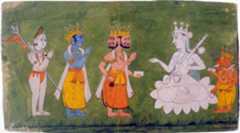Our editors will review what you’ve submitted and determine whether to revise the article.
Shaktism
Shaktism,worship of the Hindu goddessShakti (Sanskrit: “Power” or “Energy”). Shaktism is, together withVaishnavism andShaivism, one of the major forms of modernHinduism and is especially popular inBengal andAssam. Shakti is conceived of either as the paramount goddess or as the consort of a male deity, generallyShiva.
Many Hindus worship Shakti as the divine mother who calls for absolute surrender.Yogis regard Shakti as the power, lying dormant within the body as a coiled serpent (kundalini), that must be aroused and realized to reach spiritual liberation. Shaktism is an essential part of HinduTantra, a system of practices involving the worship of the goddess and designed to empower and release bothmind and body.
- Related Topics:
- Hinduism
- Shakti
- Tantric Hinduism
In popular worship, the goddess Shakti is known by many names; Hindus regard all female deities as her differentmanifestations and may refer to her simply as Devi (Goddess). In her beneficent aspect she is known variously as Uma,Parvati, and Ambika. In her fierce, destructive aspect she is represented as the blackKali, the demon-destroyingDurga, and the goddess ofsmallpox,Shitala. The goddess is also worshipped as the graciousLakshmi, who is the consort ofVishnu.

